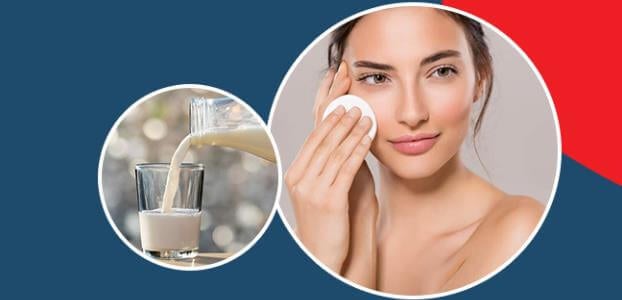Your Mom must have run after you to finish a glass of milk every day in your childhood. Now it is time for you to run after milk. Drinking processed or cooked milk is beneficial for the body as it is rich in proteins, carbohydrates, calcium, vitamin D, and phosphorus.
These nutrients help in making bones and the body stronger. But are you aware that milk is also rich in some vitamins and acids that are beneficial for the skin? Additionally, the quantity of such nutrients is higher in raw milk as heat can reduce the content of such contents.
Milk was used by women in the old times to make their skins glow. In the present day, milk is a key ingredient in many skincare products. However, milk can be used as it is in several DIYs. So, let us know about the uses, benefits, and potential side effects of using raw milk on the face here.
What is Raw Milk

In simple words, the milk which has not undergone any processing is known as raw milk. Processing includes cooking, boiling, pasteurization, heating, or evening adding of preservatives. Raw milk is the milk straight out of a milk farm into your hands.
A study on the
Effects of Heat Treatment on Milk
shows how the chemical composition of milk is changed on processing it. (1) So, raw milk is richer in milk proteins, lactulose, vitamin B6, vitamin B12, folic acid, niacin, lactic acid, and more nutrients.
Moreover, milk is heated to make it suitable for drinking as some people might get nausea and diarrhea by drinking raw milk. On the other hand, raw milk is perfect to be used on the skin.
How to Use Raw Milk on the Face
1. Raw Milk as a Facial Cleanser
Raw milk is the perfect cleanser for the face as it does not remove the required oils and natural moisture from the skin. Instead, it gently removes impurities, dust, dirt, and excess oils rooted deep in the skin.
You can use raw milk alone as a facial cleanser and can also add turmeric in it for evening out the skin tone.
2. Milk as Natural Exfoliator
Milk contains lactic acid which enables it to be used as an exceptional natural exfoliator. To use milk as an exfoliator, you can add milk to any exfoliating ingredient of your choice like gram flour, papaya paste, rice powder, or charcoal.
After mixing the ingredients, gently rub this paste onto your skin to remove dead skin cells and stimulate the regeneration of new cells.
3. Milk as Toner
Milk when used with rose water helps in toning uneven skin, brightening the complexion, moisturizing the skin, and improving the elasticity of facial muscles. You can use this toner as you like and leave it overnight as well.
Moreover, you can add a few drops of lemon juice to your freshly prepared toner.
4. Milk Masks
There are several facial masks that can be made with milk. For example tomato and milk masks for removing tan, milk, and honey to moisturize the skin, milk, and rice flour to make skin glassy, and milk and yogurt for the glow.
You should add equal amounts of both ingredients and keep the mask on for 15-20 minutes and wash your face with lukewarm to normal water.
Benefits of Raw Milk for the Face
1. Prevention and Treatment of Acne
Although drinking milk and other dairy products aggravates breakouts in people with acne-prone skin, applying raw milk to the face can help in the treatment of acne as it contains lactic acid. Lactic acid clears the skin of impurities and dead skin cells that clog the pores and cause acne.
A study on the effects of
Lactic acid on skin
shows how lactic acid can reduce acne by 90% or more. (2)
2. Brightening of Skin Tone
In addition to lactic acid, milk has vitamin B12 and minerals like magnesium that brightens the skin tone naturally. The accumulated effect of reduced acne, better skin elasticity, de-tanning, and moisturizing makes the skin appear bright and supple.
3. Anti-Aging
Milk contains vitamin D, calcium, and iron. Iron strengthens the skin barrier and helps it fight free radicals that cause premature aging. Vitamin D and calcium stimulate collagen production in the skin and make it more elastic, firm, and youthful.
A study illustrates the association of
calcium with aging
. (3)
4. Dealing With Hyperpigmentation and Tanning
First of all, milk has excellent skin-whitening agents like lactic acid that helps to deal with tanning. But most of the time, acne scars and blemishes are a major cause of hyperpigmented spots.
Milk contains vitamin A that boosts the production of proteins like keratin in the skin and also stimulates the regeneration of new skin cells while removing the old ones. So, it treats hyperpigmentation. Further, you can study the
role of vitamin A in acne
. (4)
5. Moisturizing the Skin
Milk contains poly and monounsaturated fats that moisturize the skin and make it soft like a baby. A study on
skincare and fats
explains how unsaturated fats can make skin hydrated and plump. (5)
In addition, milk also has minerals and vitamins that hydrate the skin and regulate oil production. So, milk can be an organic, lightweight, and natural alternative to moisturizers.
6. Treatment of Sunburn, Skin Redness, and Inflammation
Milk is a soothing agent. So, cold milk immediately soothes sunburns, irritation, skin redness, and inflammation when applied to the skin. Moreover, milk has antioxidants that counteract skin damage caused by sun exposure, free radicals, or an unhealthy lifestyle.
Research on
Milk proteins and their uses in cosmetology
shows how milk helps in treating sunburns, ulcers, or scars. (6) However, milk cannot replace sunscreens. So, you should
choose the best sunscreen
for yourself.
7. Making Skin Radiant and Glowing
As milk is a natural exfoliator, it gets rid of things like dead skin cells and other impurities. So, the skin becomes radiant, glowing, and fresh. This is because of the presence of potassium that nourishes the skin, magnesium that gives skin a youthful glow, beta hydroxy acid that removes the top layers of the skin, and lactic acid that exfoliates the skin.
These acids are great exfoliators as explained in
AHA and BHA for the skin.
(7)
8. Fighting Infection
Milk can help in fighting infection caused by bacteria and fungi as it strengthens our physical defenses against such microorganisms. This is because milk cleanses the skin from the inside out, strengthens immunity, removes dead cells, and clears excess oils.
However, this effect is mild on the topical application of raw milk. Rather it is associated with drinking milk.
Side Effects of Raw Milk

If raw milk is not contaminated during transport and is well preserved by taking care of hygiene as it reaches you, there are rare chances of raw milk causing any side effects. However, some people might face the following side effects and they should avoid putting milk on their face.
1. Hypersensitivity Reactions
Although drinking milk causes nausea, vomiting, and similar symptoms in people who are intolerant to lactose, topical application of raw milk can cause side effects in people who either have hypersensitive skin or who are specifically allergic to dairy products.
Hypersensitive reactions triggered by raw milk have symptoms like itching, redness, little bumps, hives, and inflammation. This reaction might also be caused by contaminated raw milk.
2. Clogging Pores
Milk is lightweight and does not trigger or aggravate acne even in people with acne-prone skin types. However, in rare cases, it can clog the pore and cause acne, especially in women with oily skin when it is not cleansed well before the application of raw milk.
Furthermore, you can find more
foods that cause acne
here.
Final Verdict
Raw milk is full of the ingredients you look for in skincare products. It has vitamins like vitamin A that manage acne and acne marks, calcium, magnesium, and phosphorous that strengthen skin, lactic acid, and beta hydroxy acid that exfoliates the skin, vitamin B complex that helps in nourishing the skin, fats that moisturizes the skin, and lastly, vitamin D that helps in anti-aging.
All ingredients of milk are super beneficial for the skin as I have explained by the reference of several studies. But sadly, the quantity of such ingredients is low in milk. So, you will have to be patient with the results of raw milk on the face just like with any other DIY skincare.
References
1. Sarah Moore, (2021, April). The Effects of Heat on Milk. News Medical Life Science. April 12, 2021.
news-medical.net/health/The-Effects-of-Heat-Treatment-on-Milk.aspx
2. WebMed Editorial Contributors, Dan Brennan MD (Oct 2021). What To Know About Lactic Acid For Skin Care. Radiance by Webmed. October 25, 2021.
www.webmd.com/beauty/lactic-acid-for-skin-care
3.
Mark Rinnerthaler
,
Maria Karolin Streubel
,
Johannes Bischof
,
Klaus Richter
(sep 2014). Skin Aging, Gene Expression, and Calcium. Pubmed. September 15, 2014.
pubmed.ncbi.nlm.nih.gov/25262846/
4. Cynthia Cobb (May 2020). Vitamin A for Acne: Does it Work? Medical News Today. May 14, 2020.
medicalnewstoday.com/articles/vitamin-a-for-acne
5. Wendy C Fries (Oct 2010). Natural Skin Care: The Skinny on Fats. Radiance by Webmed. October 28, 2010.
www.webmd.com/beauty/features/natural-skin-care-skinny-fat
6.
Kinga Kazimierska
and
Urszula Kalinowska-Lis
. (May 21). Milk Proteins – Their Biological Activities and Use in Cosmetics and Dermatology. Pubmed Central. May 28, 2021.
www.ncbi.nlm.nih.gov/pmc/articles/PMC8197926/
7. Evan Starkman (April 2021. AHA and BHA for Skin: What to Know. Radiance by Webmed. April 29, 2021.
webmd.com/beauty/aha-bha-skin-exfoliate

 By myulikeadmin
By myulikeadmin





